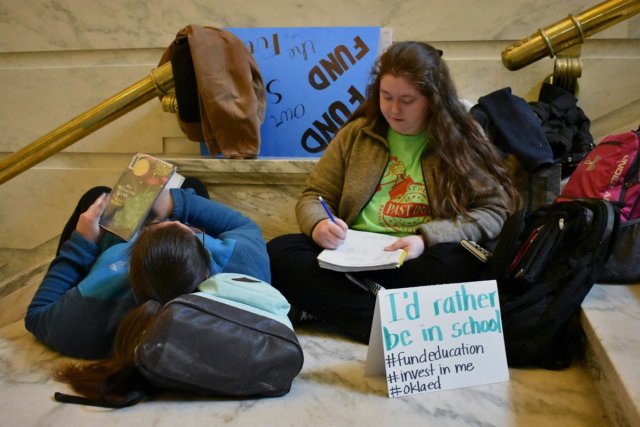
Education watchdogs have long looked to test scores as we consider the condition and efficacy of a state’s education system. During the peak civic engagement and civic learning of April’s teacher walkout, however, a theory was reaffirmed that standardized testing may fail to effectively measure student learning.
Spring standardized testing is behind us, and those with a critical eye to education should note test results when preliminaries are released this summer. The personal value of such test results for students and the collective value for our communities should be contemplated as compared to the educational results of the walkout.
Understanding the widespread role of ACEs
Indeed, the walkout may offer a critical litmus test for how best to understand Oklahoma’s test scores, which have ranked among the worst nationwide since 2015. To fully understand test scores, however, one must first understand and recognize the role adverse childhood experiences (ACEs) play in student development.
According to America’s Health Rankings data from 2016, Oklahomans under 18 have the highest ACEs rate in the country: 33 percent of Oklahomans under 18 have had at least two. These ACEs include but are not limited to:
- socio-economic hardship,
- living with someone who was mentally ill or suicidal,
- witnessing domestic violence,
- and having a parent who served time in jail (Oklahoma exhibits the highest rate in the nation for this ACE, according to data from 2016).
In light of the high incidence of trauma among Oklahoma’s young people, it comes as no surprise that tests geared to measure students at peak academic performance consistently fail to highlight how bright our students are.
The gap between students’ true ability and test performance leaves many educators searching for alternative strategies and fighting for more humane measures of learning. In this search, resilience has arisen as a key trait of the truly well-educated student. It can be personal, social or economic, but resilience allows students to successfully navigate the world in a way knowledge alone does not.
Building resilience makes for a culturally relevant education
Many educators have been working to build student resilience through lessons and projects that help students identify and address the root causes of their real-world hardships. In Oklahoma, no kind of education could be more relevant. How much more useful would a chemistry class be if its main application would help you better understand the mechanisms that make you cramp when your stomach is empty?
We can measure the success of the walkout in dollar signs or in the number of new candidates who filed for office, but the civic knowledge and civic skills teachers, students and parents gained during their two weeks at the Capitol – which were evident in the moment – may be evanescent if no one quantifies them.
The adage, “If it isn’t tested, it isn’t taught,” applies to the complex phenomena of project-based learning, too. Just as at the state level, education advocates must pay attention to everything they learned at the walkout to build a resilient movement. Schools must find accurate ways to pay attention to, measure and reward learning that emerges at the nexus of knowledge acquisition and skill implementation. This attention will help build resilient students.
Students learn deeply when their out-of-school experiences directly connect to what is happening in the classroom. The key to maintaining momentum for the type of complex, practical learning that crescendoed during the walkout will be to implement curricula and accountability structures that draw the outside in, so teachers and students don’t have to walkout to forge those connections.
Standardized testing in its most familiar incarnation sought to make public education the great equalizer it was intended to be. Instead, such tests have merely exacerbated the disparities faced by so many Oklahoma students: disparities of wealth, hunger and trauma. When 2018 test scores roll in, we may be forced to face the reality that hungry students, fearful students, disaffected students do not test well. And then we must forge a new path.
Civics education built to teach hands-on civic engagement – the kind of resilience-building work on display during the walkout – must be the infrastructure of a culturally relevant education system.
High school senior: ‘Change is always a part of life’
Earlier this year, the Federal Department of Education approved Oklahoma’s ESSA plan, Oklahoma EDGE, which has promised some freedom from standardized testing. Several new ESSAs require “… that states adopt a gauge of school performance that doesn’t involve state test scores and graduation rates.”
During the walkout, Devin, a senior at U.S. Grant High School, said, “There will always be times for change. Making change is always a part of life.”
We must build on Devin’s wisdom and make the changes to testing and accountability that will lead to an immediate and culturally relevant curricula that creates advantages for students from diverse social conditions. We must begin to see civic engagement as a hallmark of school quality.





















